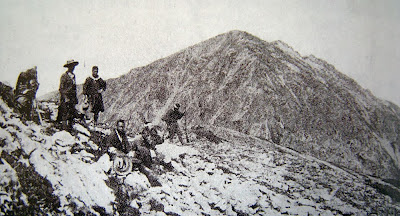Everyone has a golden age. Kojima Usui’s started in 1905, when he instigated the Japanese Alpine Club, and lasted until the mid-teens of the century. That was when the Army surveyors started publishing the first modern maps of Honshū’s high mountains, stripping them of mystery. Until then, the gentlemen alpinists had to follow their noses and, of course, their expert guides.
 |
| On the col below Warusawa-dake (photo taken on Kojima's 1909 expedition) |
"From time to time, we could see through the trees, on the other side of the valley, a mighty peak, bare-topped and reddish, in the midst of the Akaishi range. When I asked Kōhei, our hunter-guide, what it was, he called it Warusawa on account of the extremely dangerous gully that drains the waters of this mountain into the Nishimata. This sounded much as if he had just said the first thing that came into his mind. As there are neither books nor people to tell you the names of the mountains, rivers, and places hereabouts, I am recording everything just as I hear it from Ōmura Kōhei."
 |
| Survey marker on Mae-Hodaka (1909) |
Such encounters were not uncommon. For all of Japan’s high mountains had been climbed before – indeed, people had been climbing most of them for centuries. So there was base alloy in this golden age. Kojima had borrowed the term from the early European alpinists, who'd fought their way to the top of icy unclimbed peaks. In Japan's golden age, by contrast, the first ascents had all been done long ago.
This was a truth that repeatedly obtruded. Back in 1902, Kojima had hoped to make the first ascent of Yari-ga-take, then thought by some to be Japan's second-highest mountain. Instead, he found an Army survey marker waiting for him on the summit. Much the same thing happened in 1909, when he led an expedition into the Southern Alps. Atop Warusawa-dake, his party found signs that others had been there before them:
Three shrines of unvarnished wood stood there and a rusted iron banner leaned into a rocky niche. And nearby, the pilgrims had left scattered on the ground wooden tablets inscribed with the name of the deity Arakawa Daimyōjin. (Nihon Hyakumeizan).
 |
| Survey tower on Akaishi |
Still, a golden age is what you make it. In the same memorable summer, Udono Masao, a civil servant on leave from Korea, achieved what was almost certainly the first crossing of the Dai-Kiretto. No monk or surveyor had ever ventured onto this fearsomely exposed ridge between Kita-Hodaka and Minami-dake in the Northern Alps.
And sometimes the Sangaku-kai men made genuine geographical discoveries, as when, in 1907, Shimura Urei, a teacher and pioneer mountain photographer, looked down from the summit of Washiba-dake:
 |
| Kojima's expedition sets out (sketch by Ibaraki Inokichi) |
Soon, the surveyors would come out with accurate 1:50,000-scale maps of the Northern Alps, eliminating the last opportunities for such finds. With the maps would come mountain huts and new hiking trails. Many more people would be able to enjoy the mountains - yet something would be lost. As Fukada Kyuya would one day put it, “Today, mountaineering is much more convenient but it has lost this element of surprise and wonder.”
References
All photos copyright of Yama to Keikoku illustrated history of Japanese mountaineering (目で見る日本登山史 by 川崎吉光、山と渓谷社).
2 comments:
I wonder if the protagonists of a Golden Age are aware at the time that they're living in a Golden Age, or does it become golden later on when looking back at what was achieved? I suspect it's the latter in most cases, but there are times when the former is certainly true. I remember Krzysztof Wielicki at a slideshow in Warsaw some years ago relating how he had been discussing this very idea with Chris Bonington, and they'd concluded that they were immensely lucky to have been born at the time they were born. I think he knew full well that he and the rest of the Polish activists of the 70s and 80s were living something momentous.
But there has to be something more than just pure luck and timing... It takes men and women with the right stuff to turn opportunity into history. It's a creative act, a sort of alchemy...
Thanks for making the Japanese Golden Age a bit more accessible to those of us who can't read fluent Japanese, Project H! And keep us updated about when the book will be coming out... Waiting with bated breath!!
That's an interesting question you've raised, Tony - Kojima wrote about the Japanese "golden age of alpine exploration" in an essay called "Yama, mata yama" collected in his "Alpinist's diary". The essay was written after the golden age, of course, but I'm not sure how long after. As for the Polish "golden age", I've just been reading Bernadette Macdonald's impressive "Freedom climbers" about that very subject. Yes, that too was a "golden age", albeit with a tragic element running through it....
As for The Book. Editing and design is now under way, so "next year" seems a good bet. Sorry this has all taken a long time.
Post a Comment